Read our most important findings.
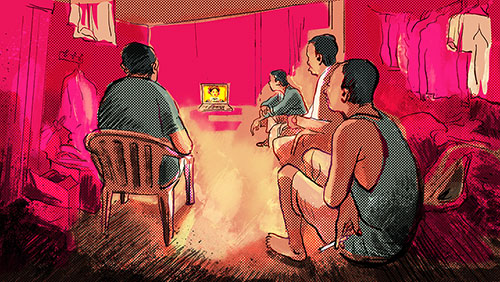
(Dan Carino for LAist)
On a recent afternoon, holding a lit cigarette between his fingers, Hengbin Wu sat in an old desk chair and watched a Chinese TV series on YouTube in his two-bedroom apartment in Monterey Park. At any given time, the 58-year old shares the small space with up to nine other Chinese immigrants.
In the faint light coming through the window blinds, three beds, a nightstand and a locker were tightly arranged along the living room walls. A fourth bed was pushed up against a wall next to the kitchen, where a well-fed rat made two brief appearances.
Mixing with the smell of mold, smoke from Wu’s unfiltered Premier wafted toward an unpainted patch of ceiling where a smoke detector used to be. When asked about the missing device, he said he removed it so he could light up inside.
Welcome to the modern-day tenements of L.A.’s San Gabriel Valley. Known in the community as “boarding houses,” apartments like Wu’s are home to thousands of Chinese immigrants who live in overcrowded, unsanitary and potentially deadly conditions for days, weeks or months at a time.
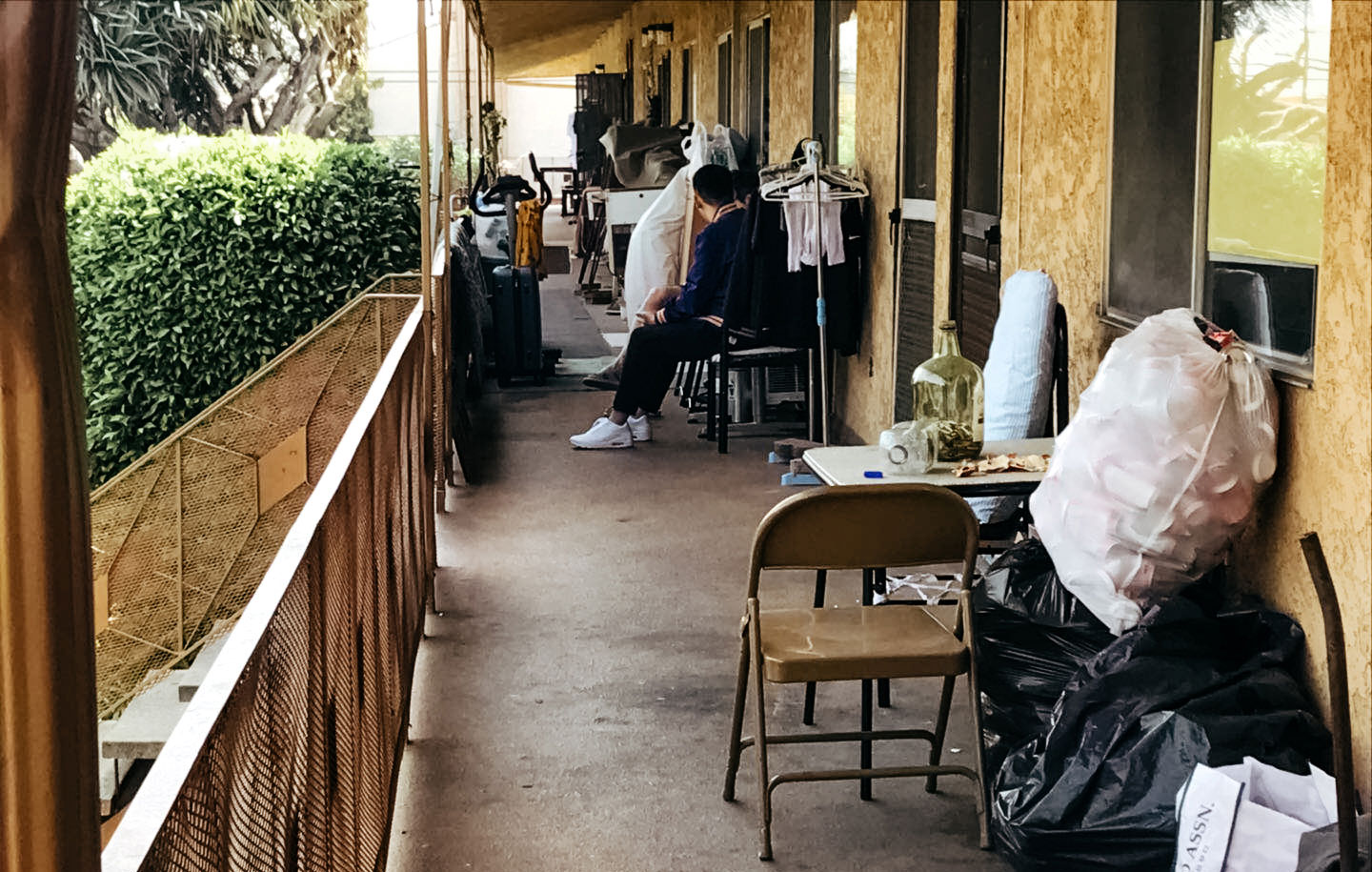
Two tenants in front of their apartment’s door at a complex on Lincoln Avenue in Monterey Park. (Yingjie Wang/LAist)
Many of these boarding houses operate in violation of housing laws. Those laws can vary slightly from city to city, but generally speaking, they say that no more than three people can live in a one-bedroom unit, and no more than five people can live in a two-bedroom unit.
KPCC/LAist spent several months visiting boarding houses throughout the region, and conducting more than 60 interviews — many in Mandarin — to get a better understanding of how tenants are living and why substandard conditions persist despite repeated vows by city leaders to crack down.
These visits revealed overcrowded dwellings that were often divided by slapdash walls of plywood or drywall. If that’s too pricey, tenants resort to shower curtains for privacy. In apartment complexes, condominiums, single-family homes and converted garages, boarding house tenants endure rodents, insect infestations, leaks and mold, as well as theft, fights among themselves and other consequences of living cheek-by-jowl.
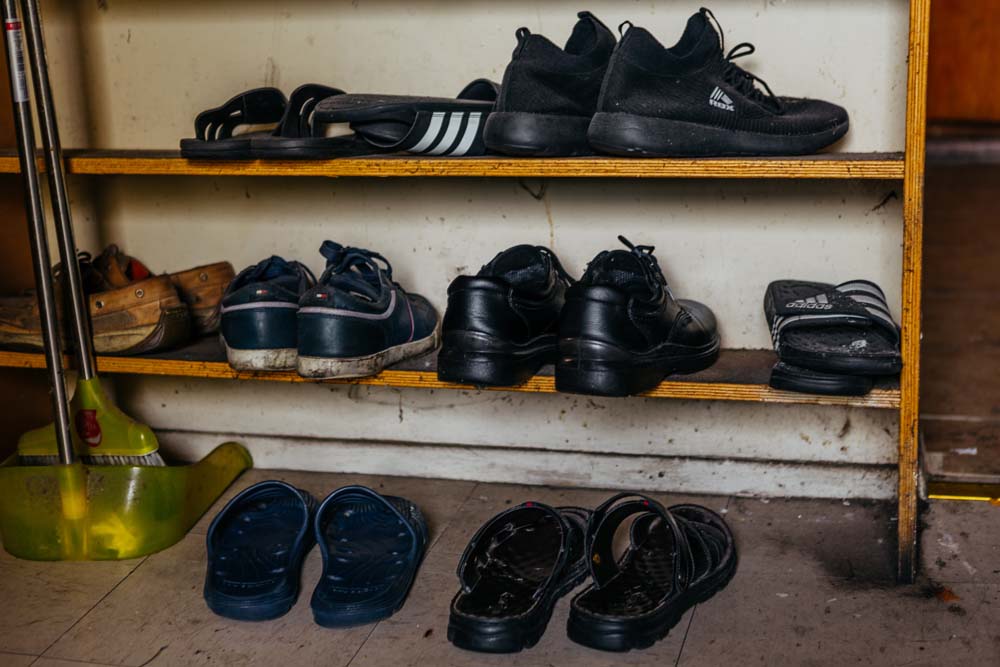
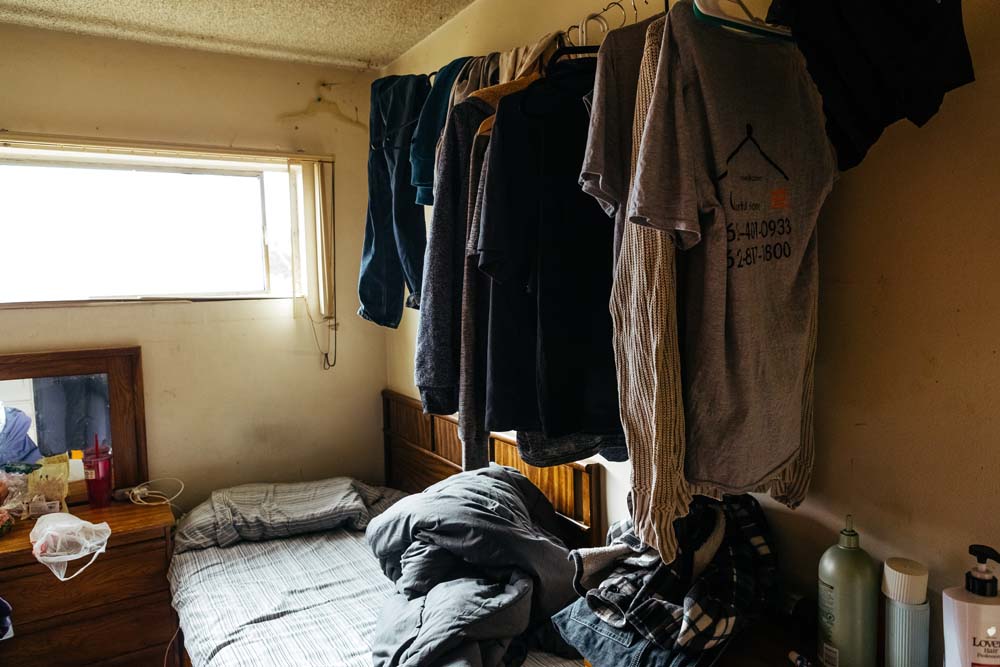
The shoes of multiple boarding house occupants. Tenants hang clothes above their beds. (Chava Sanchez/LAist)
In the worst cases, too many boarding house tenants have short-circuited electrical systems, causing fires, Monterey Park councilmember and former Mayor Peter Chan told KPCC/LAist in a recent interview. “Once you have a fire, you don’t know how it goes. It can spread to other units, the neighbors,” he said. “It is a very dangerous situation.”
Scott Haberle, who until this February was Monterey Park’s fire chief and code enforcement supervisor, told KPCC/LAist that boarding houses can be a major fire hazard, with missing smoke detectors and blocked exits. “You have more people in the room than you’re supposed to, so they have limited exit-ability to get out,” he said.
ADVERTISEMENT
Immigrants often pay by the night to get a roof over their heads, making landlords a profit even as they flout housing and safety codes.
The San Gabriel Valley is home to one of the highest concentrations of Chinese people in California, and in the U.S. KPCC/LAist investigated boarding house conditions and analyzed data provided by four San Gabriel Valley cities with high numbers of Chinese immigrants living at the bottom rung of the housing market: Monterey Park, San Gabriel, Alhambra and Rosemead. Together, those cities have a combined population of about 241,000 people, 40% of whom are Chinese, according to census data. Those cities have opened at least 650 boarding house-related code enforcement cases since 2013. Many officials and experts believe the number of unreported cases is far higher.
Haberle described the boarding house situation as “prolific at times.”
We are the bottom level in China and still the bottom level in America. Human rights? I have never thought about human rights. I am just like a little grass...struggling to survive. — Yang
Chinese immigrant and San Gabriel Valley boarding house tenant
His concern is nothing new. Five years ago, the Monterey Park City Council issued a report warning of “unsafe conditions” in the city’s “non-permitted boarding houses.” Yet the city still has the highest number of boarding house cases in the San Gabriel Valley, according to public records provided to KPCC/LAist.
The lack of oversight — in Monterey Park and elsewhere — comes down to code enforcement that is essentially toothless, fines that are relatively low and policies that prevent inspectors from even entering a building unless someone has filed a complaint and a tenant or landlord grants them permission to enter.
“If no one reports them, we let it go,” Monterey Park councilmember and former Mayor Peter Chan told KPCC/LAist in a recent interview, adding, “we won’t actively hunt” tenants or building owners.
There’s also a moral dilemma in a region where many people are barely hanging on to housing: City officials are hesitant to shut down boarding houses for fear of driving tenants into homelessness.
We don't have paywalls, but we do have payments (aka bills). So if you love independent, local journalism, join us.
“If we try to eliminate all the illegal residential motels,” said Chan, using another commonly used term for boarding houses, “we push them to the streets.”
It’s an environment that leads Chan to make judgement calls. A few years ago, he recalled, there were cases in which 30 to 40 people were crammed into a single-family home. He says apartments with “only seven to eight, under ten people,” aren’t nearly as troubling.
Given how much worse things could be in so many boarding houses, Chan says the city often chooses to look the other way. “Although it’s still illegal,” he said, “it’s reasonable” and “acceptable.”
MONTEREY PARK AND BEYOND
Our analysis shows that since 2013, the city of Monterey Park has opened at least 400 boarding house-related cases at about 300 properties.
Sources: Code enforcement offices of Alhambra, Monterey Park, Rosemead and San Gabriel
The city of San Gabriel has opened about 230 illegal boarding house cases since 2011, according to data reviewed by KPCC/LAist. Lt. Ray Lara, of the San Gabriel Police Department’s investigation division, said officers come across boarding houses “maybe once a month” during routine calls for service. “I would venture to guess that, although we’ve encountered some, there are probably many more that we’re not aware of,” he said.
Justin Edson, who until recently was a senior officer in San Gabriel’s Neighborhood Improvement Services department, estimated that in half of the city’s boarding house cases, the owners are “basically orchestrating the activity.”
Records provided by the city of Alhambra show only nine boarding house cases since January 2014. Yet one well-known case was not included on that list. After KPCC/LAist sent a second records request to Alhambra, the city produced a new batch of documents, which revealed 19 possible illegal boarding house cases in 2014 alone. Alhambra city councilmember, Adele Andrade-Stadler, was open to the possibility that things might be worse than they appear.
ADVERTISEMENT
“If these numbers in Monterey Park and in San Gabriel are this large,” she said, “then I would bet that Alhambra's are probably larger than what you have in front of me.”
Records provided by the city of Rosemead show just seven properties identified as boarding houses since January 2013.
However, several sources, including government employees and immigrants with deep ties to the San Gabriel Valley’s Chinese community, speculate there are many more boarding houses in that city. As one former Monterey Park city official, who asked not to be identified, put it: Those statistics “can’t possibly be right.”
KPCC/LAist asked officials in Rosemead about the discrepancy between the data and what sources speculated. Ben Kim, Rosemead’s assistant city manager and the supervisor for the city's code enforcement division, declined an interview request.
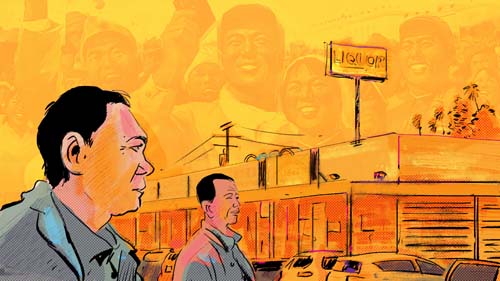
(Dan Carino for LAist)
GETTING HERE
For people living in boarding houses, the journey starts in China, where impoverished, often rural people seeking financial opportunity promise to pay up to $60,000 to travel agencies, or in some cases “snakeheads” — the Chinese equivalent of Mexican “coyotes” — who help them get visas and transport them to the United States. Prices are determined by city of origination and how complicated the process is.
Once in the U.S., the immigrants are essentially trapped in a world dominated by more established and powerful immigrants, who provide them everything from housing to work to legal representation as they seek permanent residency.
Twenty-nine-year-old Yang, who asked that his full name be withheld due to his pending immigration status, was one of the tenants sharing the boarding house with Wu. Yang is from Shenyang, in northeast China’s Liaoning Province, and arrived in the U.S. three years ago on a student visa. Like so many immigrants, he applied for political asylum and got authorized to work while his asylum case was pending.
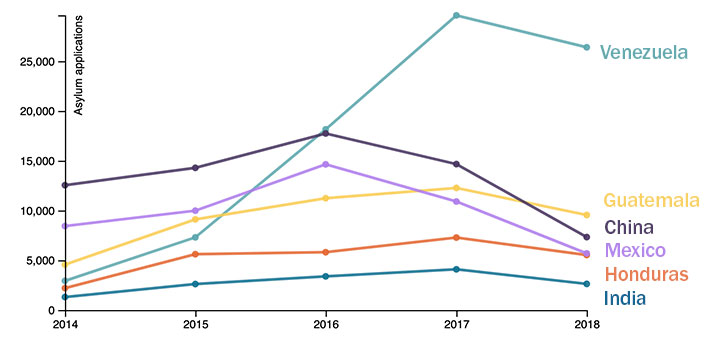
Source: U.S. Citizenship and Immigration Services
This process took more than six months. He said he paid $3,000 to a middleman who helped arrange work authorization, $4,000 to $5,000 for legal assistance with his asylum case, and a $40 finder’s fee for each restaurant job he found through an agency. People in Yang’s situation usually earn substandard wages, and also rely on money from close relatives or unscrupulous lenders.
“I was all on my own after I arrived,” Yang said. In this cutthroat environment, he added, “Family is not real family, friendship is not real friendship, everything is related to money and benefit.”
Yang’s first job here was washing dishes in restaurant kitchens. Soaked in soapy water for too long, his nails got infected by bacteria; they’re still grey and rough. After about three years, he left restaurants to work as a truck driver.
Yang said his meager earnings left him with no choice but to live in boarding houses. Despite the difficulties of his new life, he still thought his future here is brighter than it would be back in China, where he made less than $430 (3,000 yuan) a month working for the government as a contractor.
“We are the bottom level in China and still the bottom level in America,” Yang said. “Human rights? I have never thought about human rights. I am just like a little grass, trying my best to get some sunshine and some rain and dew, struggling to survive. I can still survive here. I would dry up and die in China.”
Many immigrant workers like Yang have gone into debt for their “transportation fee.” Most of them also have families back home who count on them to send money.
Still, Chinese nationals scramble to put their names on travel agencies’ lists and wait months, even years, for a chance to come to America.
A female masseuse who also lived with Wu, and asked that her name not be used, said she waited half a year. She’s from Tianjin, a major port city in northern China. She said she came to America after her daughter was admitted to a prestigious Chinese college four years ago and her ex-husband refused to pay alimony. She has been here for four-and-a-half years and has not returned to China. She said that all her dreams – surviving, supporting her daughter and saving for retirement – are only possible in America. When she misses her daughter, they video-call on WeChat, a widely used social media app in China. “At least I can still see a little light in my life here,” she said.
Boarding house residents come from many backgrounds and have ventured to the U.S. for a variety of reasons. There are young rural men who’ve come to earn the “bride price” required to get married. Some older women and men are here to pay for their children’s education. And some people have made the journey to earn their livelihood after they turn 50, the point at which they’re replaced by younger laborers in China.
The boarding house that Wu and the others occupy is one of 26 units in an apartment building in the heart of Monterey Park. It’s one of at least 26 buildings on Lincoln Avenue in which KPCC/LAist either saw units that appear to serve as boarding houses, or have been cited by the city.
Wu’s boarding house sheds a light on the complex world of poor Chinese immigrants in America and why these boarding houses remain a persistent issue. Interviews with more than 40 people, many conducted in Mandarin, and thousands of pages of government records, outline how the boarding house industry profits not only from lax government oversight but also from the tight-knit Chinese community. It’s a world in which those who manage to climb a rung or two up the economic ladder often extract money from those who have just arrived.
‘SECOND-HAND’ LANDLORDS
Wu, for example, isn’t just a tenant. He’s also a “second-hand landlord” who earns money by subletting his two-bedroom apartment to as many as nine roommates on any given day. The living space in his unit is a maze of tables, chairs, stacked boxes, suitcases and bulky furniture — typical in boarding houses. He holds the lease on another unit with the same floor plan downstairs, which also has 10 beds.
Here’s how second-hand landlording works: Wu rents two units in the same building for $1,750 per month each. To turn a profit, he sublets his apartment to Chinese immigrants for $15 a night; on average, at least half of the beds are taken each day, which works out to approximately $2,250 per month. Wu makes extra cash as a driver for hire. Some second-hand landlords charge more or pack more people into their boarding houses to maximize profit. Some also offer to cook for tenants, usually at a cost of about $5 a day for two meals.
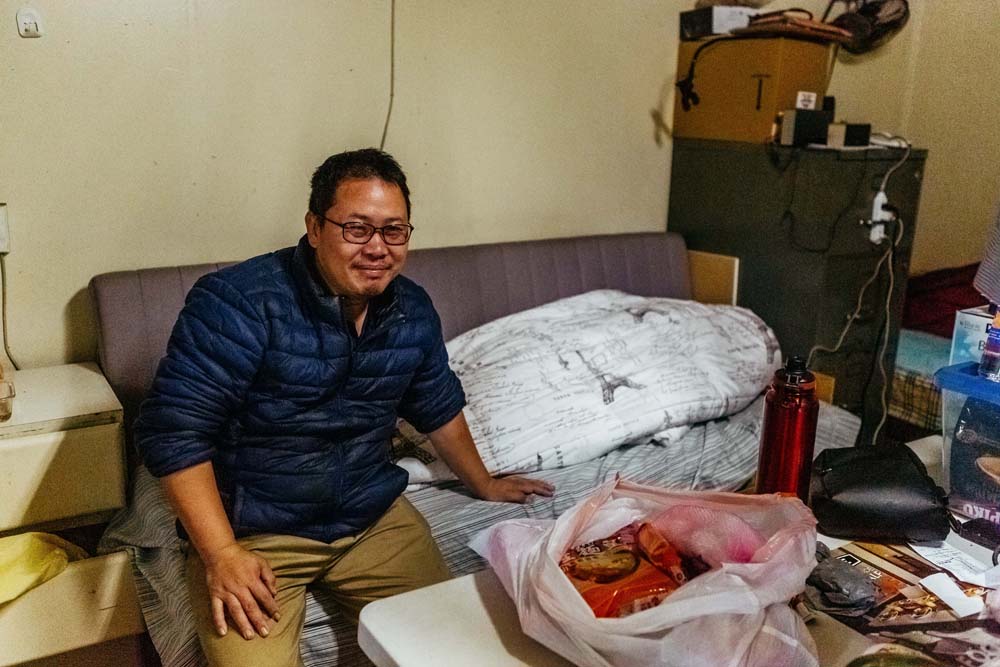
Zhang Chunsheng, a newly arrived immigrant from China, sits on the small futon he pays $15 a night for in a boarding house. (Chava Sanchez/LAist)
Wu said his rent went up $100 last year. Other second-hand landlords in Wang’s building said their increases have been much steeper. One of them said that over the last three years his rent has been raised four times, and has more than doubled, from $900 to $2,000. (There is no rent control in any San Gabriel Valley cities.) Fearful that landlords might kick them out for complaining about rent hikes, second-hand landlords told KPCC/LAist they usually remain silent; instead, they pass the cost along to their tenants.
Along Monterey Park’s main thoroughfares, especially Garvey, Garfield and Atlantic Avenues, street poles and store windows are covered with advertisements in Chinese for cheap rooms to rent in “family hotels,” another term for boarding houses.
Some second-hand landlords also leave business cards at shops around the community and post advertisements on Wechat and other Chinese-language websites, such as ChineseInLA.com, usalifeonline.com and 58.com. (In Chinese culture, the number 5 means “I” and the number 8 means “fortune.”)
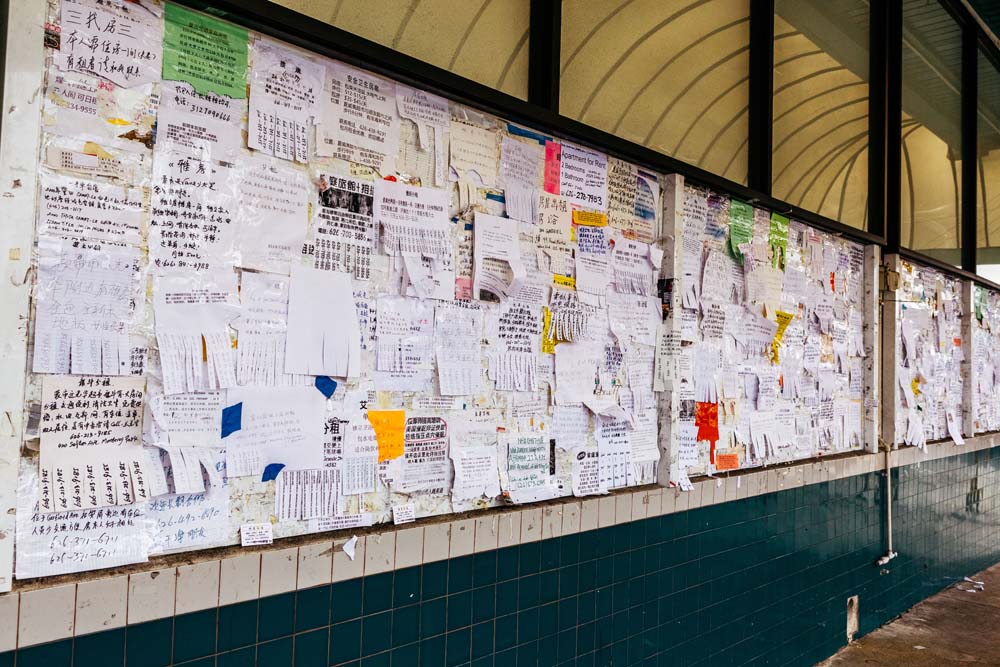

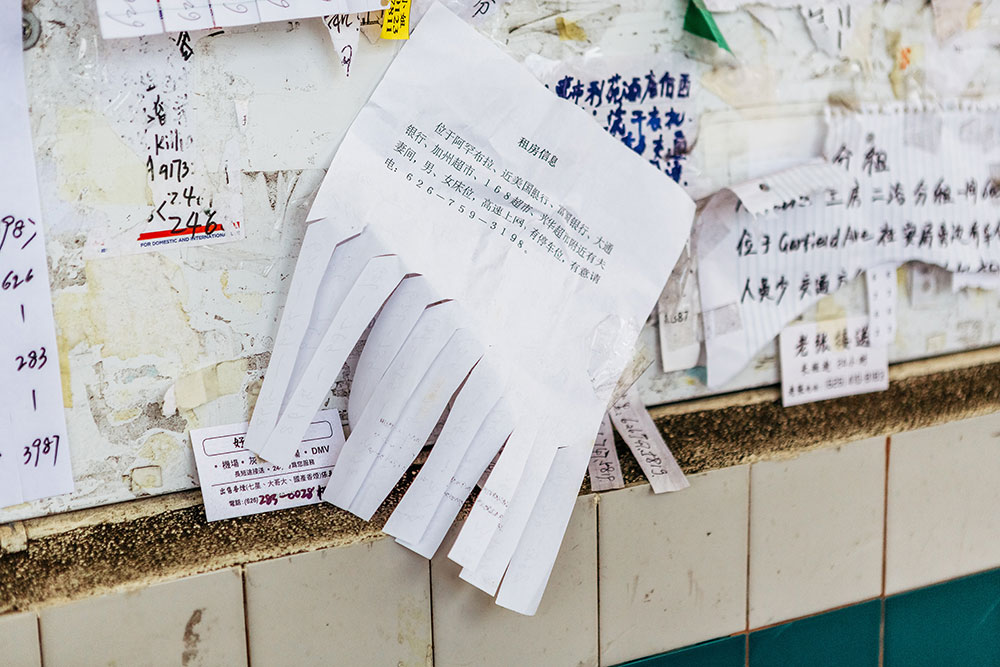
Flyers, posted outside a Chinese grocery store in the San Gabriel Valley, advertise beds at boarding houses in the area. (Chava Sanchez/LAist)
With his paunch and unkempt hair, Wu is known by people living in his boarding houses as “Lao Wu,” or Old Wu, a common and affectionate nickname. He said he arrived here 16 years ago from Yantai, in northern China’s Shandong Province, where he owned a small business. Wu said his wife encouraged him to come to America for a better education opportunity for their daughter. Wu said he paid a travel agency about $17,000 (120,000 yuan), a fortune for an ordinary Chinese family. No contract was signed. When Wu passed through immigration at LAX, a driver who’d been hired by the agency was waiting to take him to Monterey Park. His family made the final payment to the agency once he let them know he’d settled down.
Like so many of his tenants, he said he worked in the kitchens of numerous Chinese buffets in many states, including Texas, Florida and California, for months at a time. His employers provided meals and accommodation.
He usually worked 12 hours a day, six days a week, at a salary ranging from $5.80 (which is lower than the minimum wage in any state) to $8 per hour, or about $1,800 to $2,500 per month.
“The working and living situation in restaurants were so bad,” Wu said. “All the workers lived in the house rented by the bosses. People don’t talk to each other. Everyone is solitary and suspicious.”
On and off, Wu said he worked in buffets for seven years, with the occasional hiatus back in Monterey Park. He said that eventually he came down with diabetes and was no longer able to work standing up for 10 or 12 hours at a time; he also needed to take regular breaks for insulin injections.
He needed a new way to make a living.
‘BOSS WANG’
Back in Monterey Park, Wu rented a unit from Curt Wang, whose company, South Fremont 8 Investment Inc., is a part-owner of the building Wu lives in. Wu calls him “Boss Wang.”

Curt Wang, founder and owner of KoTai Realty.
Image from KoTai Realty website.
Wang is in his 70s. According to two of his employees and one former employee, he emigrated from Taiwan decades ago and is now a U.S. citizen. One of them said he comes from a prominent family.
Two of those sources said that when Wang arrived here he invested in real estate. He now presides over an empire. He is the founder and owner of KoTai Realty. According to public records, KoTai was founded in 1978. Today it is a well-known business in San Gabriel Valley real estate. KoTai is “one of the largest non-franchise real estate companies in southern California,” according to its website.
South Fremont 8, the company that owns the Lincoln Avenue building, does business as KoTai Management, which shares an address with KoTai Realty’s main office, according to public documents.Public records show that Wang has been connected to at least 23 real estate investment entities, 13 of which are still in operation.
KoTai’s manager, Kris Tseng, said the company employs or works with more than 300 full- and part-time agents and that properties and investments connected to Wang, including many apartment buildings in the San Gabriel Valley, are worth tens of millions of dollars. (Some of those properties are co-owned with business partners.)
According to public records, Wang lives in one of two homes that he and his wife own in South Pasadena.
Since 2012, Monterey Park officials have inspected the Lincoln Avenue building owned by Wang’s company at least 13 times, according to records obtained by KPCC/LAist. A Sept. 30, 2016 email, sent directly to Wang by city officials amidst a flurry of inspections and citations, lists 85 violations, including “excessive mattresses” or “excessive beds” in at least eight units, as well as mold, roaches and exposed electrical wiring.
In the same email, a city official wrote to Wang that “these deficiencies must be brought up to minimum housing standards for the health, safety and welfare of occupants.” The official admonished Wang to inform second-hand landlords “that they are in violation of your lease & City’s Municipal Code.”
Officials did not make a follow-up visit, according to public records; those records did not show that the violations were addressed, much less remedied.
That same year, the city made five visits to Wang’s building and issued two fines.
The total? $350.
The building on Lincoln Avenue is one of the largest on the street. Based on visits by KPCC/LAist to several buildings owned or co-owned by Wang’s companies, the Lincoln Avenue property appears to be the only one where second-hand landlords run boarding houses.
In a brief phone conversation last April, Wang said that if anything is amiss in his buildings, it’s because his tenants are violating their leases, and he can evict them. Wang declined to answer more questions and hung up.
At least 10 recent visits to the building by KPCC/LAist suggested little has changed: In November, for example, five units appeared to be equipped to sleep up to a total of 56 people.
To me, they should not be landlords at all. They should be in jail. — Min Zhou
UCLA sociology professor
In February 2020, when reached by phone again, Wang hung up immediately.
At that point, KPCC/LAist emailed and mailed Wang a letter with a list of findings, established through public records, on-the-ground reporting and multiple interviews, about poor conditions and boarding houses being run out of units at the Lincoln Avenue building.
Wang did not respond.
An attorney who said he represents Wang did get back to KPCC/LAist. In two phone conversations, Eugene Fu claimed that KPCC/LAist never spoke to his client, and said the findings about the building on Lincoln Avenue were incorrect. Fu did not provide supporting documentation or explanations for his claims and declined to provide an official statement.
One week after speaking with Wang’s attorney, KPCC/LAist visited again and counted 13 units in the building that appear to be operating as boarding houses. Walls were visibly moldy and electrical wiring was exposed.
The co-owners in the building with Wang’s company are a husband and wife named Wai Chi Fang and Tsuey Yuh Huang, of San Marino. KPCC/LAist hand-delivered a letter to their home in February. At the front door, Huang said she has no knowledge of the issues at the building, adding that Curt Wang is the primary property manager. Fang has not responded to the letter.
When asked about the boarding house problem in the San Gabriel Valley, Min Zhou, a professor of sociology and Asian American studies at UCLA, said “the landlords take advantage of this daunting situation of the undocumented immigrants,” who are an “easy target for abuse.” “To me, they should not be landlords at all,” Zhou said. “They should be in jail.”
Monterey Park’s former code enforcement division supervisor, Michael Huntley, summarized his concerns about the problem with a rhetorical question: “Is it fair to put those individuals in harm's way in a structure that wasn't designed for so many people — and where landlords have some illegal construction and some illegal electrical work — because they're trying to make a profit?”
TOOTHLESS WATCHDOGS
For the most part, dangerous boarding house conditions are only apparent once you’re inside. The exterior of many buildings appear to be in acceptable shape. And that’s an issue when it comes to enforcement. City officials told KPCC/LAist that if a building has no obvious violations that can be seen from the street, they can’t enter and perform unannounced inspections.
To get inside, inspectors must be responding to a complaint. But newly arrived Chinese immigrant workers without proper documentation — who might not speak English and fear eviction or deportation — are unlikely to speak up. So complaints mostly come from neighbors.
ADVERTISEMENT
Even after city officials receive complaints, landlords and tenants still can deny them access. To lawfully enter a building or unit without permission, they must have evidence of a violation. They’re essentially trapped in a Catch-22: To find evidence, they need to enter the building, but without evidence they can’t enter.
“It’s people’s property here and there’s a lot of protection with that,” said Haberle, the former Monterey Park fire chief who also oversaw code enforcement. A complaint has “got to be pretty specific,” he said. “You can’t just say, ‘There’s somebody in there.’”
Owners, managers or second-hand landlords can turn inspectors away. One second-hand landlord said he once locked the door to his unit and pretended he was out until the inspector finally left the premises.
Huntley, the former Monterey Park official, said that even if inspectors discover a code violation and levy a fine, the problem won’t necessarily be fixed. In some cases, Huntley said, “we’ll close them down. They’ll correct it. And in a year or two they come back and they’re doing it again.”
Councilmember Chan told KPCC/LAist that boarding houses pop back up just days after the cases get closed. He said that under his watch, “It happened all the time.”
Code violation fines usually max out at $1,000 — meaning it’s cheaper for a landlord to pay the fines than to keep the buildings up to code.
Wu, the second-hand landlord, has been subletting his apartments for eight years, despite multiple warnings and citations issued to the building’s owners. Two second-hand landlords said neither the building’s owners nor city officials have ever asked them to stop their boarding house businesses.
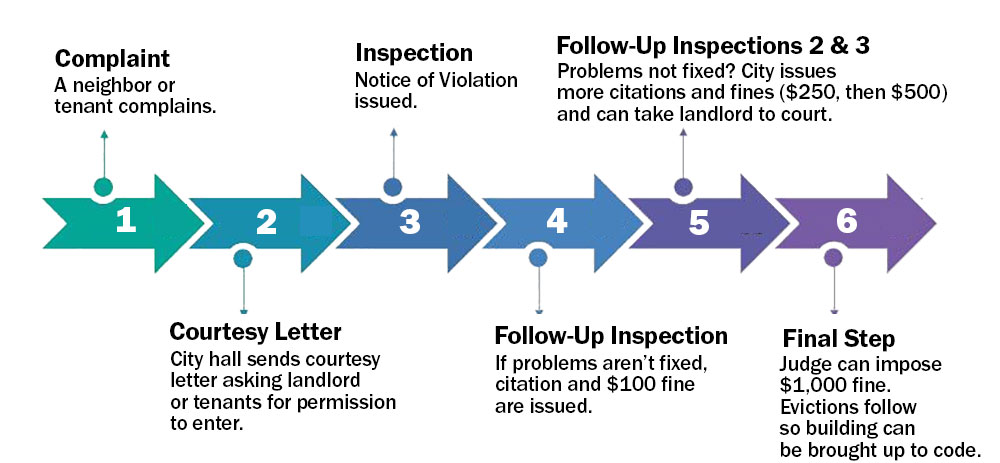
Police can’t do much about boarding houses, either. They know they’re “prevalent,” said Monterey Park Police Sgt. Bob Hung. But since building and safety code violations are only administrative violations — as opposed to crimes — Hung said police don’t enforce them, and can’t arrest landlords for violations. Instead, he said, if officers observe glaring code violations during calls for service, they will report problems to the city’s code enforcement division.
Records show police visited the building on Lincoln Avenue more than 80 times over the past five years and filed 17 criminal cases for offenses such as theft and fights.
Language can also be a barrier when it comes to authorities communicating with occupants. As of 2018, about 70% of Monterey Park residents report being of Asian descent and more than 75% of households there reported speaking a language other than English in the home, according to the most recent demographic data from the American Community Survey. Yet in a 2016 National Public Radio interview, Sgt. Hung said he was the only officer on patrol in Monterey Park who spoke any Mandarin. Hung did not respond to emails or calls asking if the number of Chinese speakers on the force had changed.
Other city agencies are also hampered by a patchwork of enforcement. Fire department officials stop by the Lincoln Avenue building at least once a year, according to second-hand landlords who live there. But Haberle, the former Monterey Park fire chief, said the law doesn’t allow the department to inspect the inside of residential buildings. Fire officials are limited to inspecting the exterior of apartment buildings to ensure, for example, that a fire extinguisher is in working order.
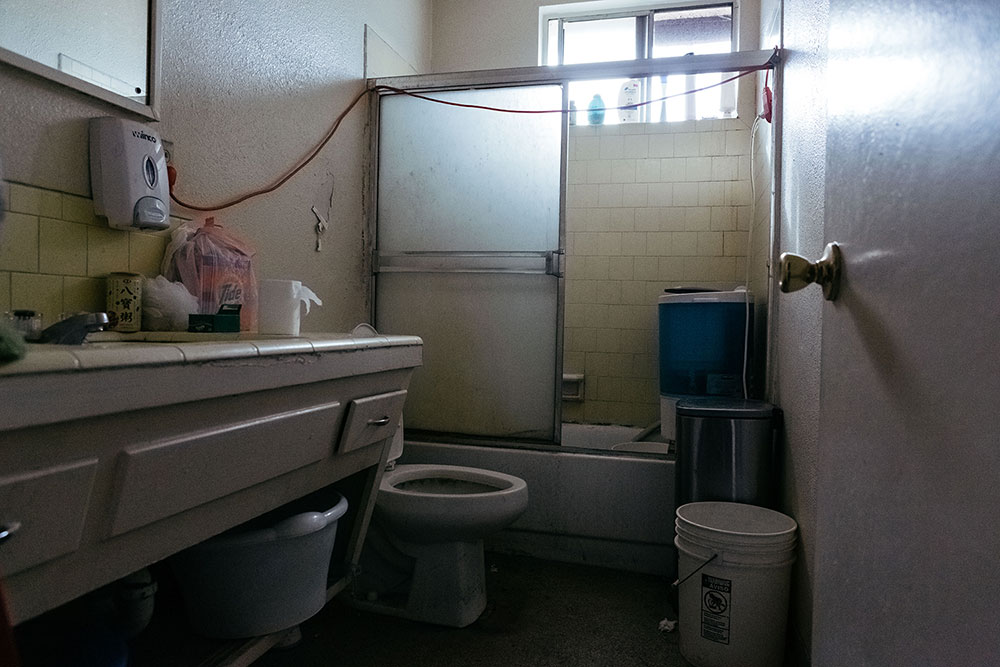
Makeshift electrical wiring in the bathroom of a Monterey Park boarding house, shared by 10 people. (Chava Sanchez/LAist)
Firefighters and paramedics do respond to emergency calls from people living in boarding houses, which allows them to enter. In those cases, Haberle said, they’re supposed to alert the code enforcement division if they observe that the premises are being used as boarding houses.
The fire department is not responsible for checking to see if interior smoke detectors are working. Instead, building managers are expected to file an annual report to the city stating that the devices are working. In other words, it’s an honor system.
In an effort to crack down on property owners running “unlawful boarding houses” that “are a public nuisance and constitute an unfair business practice,” Monterey Park city council passed an ordinance in March 2018 charging property owners the cost associated with responses by law enforcement, fire and other public services, after a first warning. According to councilmember Chan, the fees can be up to $5,000 per day.
In the nearly two years since the ordinance passed, no fines have been imposed on companies or individuals that operate boarding houses.
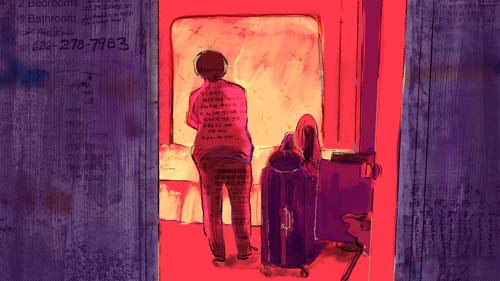
(Dan Carino for LAist)
HOME AGAIN
While many problems with boarding houses remain unresolved, second-hand landlords face another issue. Under the Trump administration, the number of asylum seekers from China dropped by half between 2017 and 2018. Second-hand landlords are feeling the pinch.
Wu said he’s seen his customer base decline in the past two years and said that he knows of other second-hand landlords who are handing off their leases.
But Wu is sticking it out. Second-hand landlording still makes financial sense for him, and his tenants have made his life in America less lonely. And loneliness is a common sentiment among many San Gabriel Valley boarding house dwellers.
On a recent evening, Wu and his tenants prepared mutton dumplings for dinner. Lao Song, one of Wu’s tenants who for years was a restaurant cook, seasoned the stuffing as Wu kneaded the dough. A 60-year-old tenant who works as a maternity matron washed dishes, then rolled the dough to flatten it for wrapping. Using their cellphones, they played old Chinese songs that were popular when they were young while waxing nostalgic about the lives they left behind.
While they cooked, Wu took a phone call from a repeat tenant asking if he had any space for the night. About an hour later, when the dumplings were plated and about to be served, the caller, a Chinese woman who appeared to be in her 50s, showed up. She walked through the unlocked front door, set down her suitcase and asked Wu, “Where should I sleep?”
. . .
Additional reporting by Elly Yu.
This report is being published in conjunction with Alhambra Source, which provided additional reporting and support.
This story was reported through dozens of interviews, thousands of pages of public documents and the analysis of the public data obtained by KPCC/LAist from the Los Angeles County Office of the Assessor and California Secretary of State.
BOARDING HOUSES
Figures regarding the number of boarding houses come from public records provided by Alhambra, Monterey Park, Rosemead and San Gabriel. These requests included information about boarding houses, notices of violations, official complaints and the logs of illegal boarding house cases that have been closed.
Records from the city of Monterey Park were obtained in 2019 and 2020. Records from the city of San Gabriel were obtained in 2019. The city of Alhambra has been providing records on a rolling basis since September 2019. Records from the city of Rosemead were obtained in 2019 and 2020.
For Monterey Park, KPCC/LAist primarily used two datasets:
To address non-standardized recordkeeping by the city of Monterey Park, KPCC/LAist picked out all the alleged boarding houses on which a code enforcement case commenced, combined the two datasets, made a comparison and deleted duplicates of the same code enforcement cases from July 2016 to March 2019.
At the time of publication, KPCC/LAist was still waiting for the city to confirm certain data points; some information might be updated.
The city of San Gabriel provided data dating back to 2011. However, some records from 2017 were missing and could not be counted.
Different cities use different systems and terminology to record illegal boarding house activity. For example, one city could use the term “boarding house” while other cities use a combination of terms, such as “home hotel” or “residential motel.” Sometimes written descriptions of violations are used in lieu of standard terminology. Due to these inconsistencies, KPCC/LAist made the most detailed requests possible in order to obtain the most comprehensive data available. When there was doubt, we went with the most conservative estimates. Missing and outstanding records, as well as possible errors in data provided by each city, mean that our map is not an exhaustive picture of boarding houses in the four cities.
KPCC/LAist also requested and reviewed records for unincorporated South San Gabriel, since that area shares a border with Rosemead and Alhambra. The 17 case documents provided did not appear to be actual boarding house cases; for this reason, South San Gabriel is not included in this article or in our map.
ENTITIES OWNED BY CURT WANG
The number of entities connected to Curt Wang is a count of active corporations, limited partnerships and limited liability corporations from California Secretary of State data obtained by KPCC/LAist in April 2019. The number was then revised by checking each entity's status on the California Secretary of State’s website; two entities were recently closed. Entities were directly tied to Curt Wang by using the address of his company, KoTai Realty, and other known business addresses, as well as various versions of his name in English and Chinese found in the Secretary of State’s database.